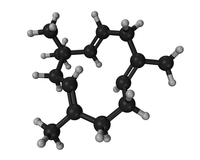Humulene
 |
|
 |
|
| Names | |
|---|---|
|
IUPAC name
2,6,6,9-Tetramethyl-1,4-8-cycloundecatriene
|
|
| Other names
alpha-Caryophyllene; 3,7,10-Humulatriene
|
|
| Identifiers | |
|
6753-98-6 |
|
| 3D model (Jmol) | Interactive image |
| ChEBI |
CHEBI:5768 |
| ChEMBL |
ChEMBL251280 |
| ChemSpider |
4444853 |
| ECHA InfoCard | 100.027.106 |
| PubChem | 5281520 |
|
|
|
|
| Properties | |
| C15H24 | |
| Molar mass | 204.36 g·mol−1 |
| Appearance | Pale yellowish green clear liquid |
| Density | 0.886 g/cm3 |
| Melting point | < 25 °C (77 °F; 298 K) |
| Boiling point | 106 to 107 °C (223 to 225 °F; 379 to 380 K) at 5 mmHg |
| Hazards | |
| Safety data sheet | MSDS |
| Lethal dose or concentration (LD, LC): | |
|
LD50 (median dose)
|
>48 mg/kg |
|
Except where otherwise noted, data are given for materials in their standard state (at 25 °C [77 °F], 100 kPa).
|
|
|
|
|
| Infobox references | |
Humulene, also known as α-humulene or α-caryophyllene, is a naturally occurring monocyclic sesquiterpene (C15H24), containing an 11-membered ring and consisting of 3 isoprene units containing three nonconjugated C═C double bonds, two of them being triply substituted and one being doubly substituted. It was first found in the essential oils of Humulus lupulus (hops), from which it derives its name. Humulene is an isomer of β-caryophyllene, and the two are often found together as a mixture in many aromatic plants.
Humulene is one of the components of the essential oil from the flowering cone of the hops plant, Humulus lupulus, from which it derives its name. The concentration of humulene varies among different varieties of the plant but can be up to 40% of the essential oil. Humulene and its reaction products in the brewing process of beer gives many beers their “hoppy” aroma. Noble hop varieties have been found to have higher levels of humulene, while other bitter hop varieties contain low levels. Multiple epoxides of humulene are produced in the brewing process. In a scientific study involving gas chromatography–mass spectrometry analysis of samples and a trained sensory panel, it was found that the hydrolysis products of humulene epoxide II specifically produces a “hoppy” aroma in beer.
α-Humulene has been found in many aromatic plants on all continents, often together with its isomer β-caryophyllene. Proven α-humulene emitters into the atmosphere are pine trees, orange orchards,marsh elders, tobacco, and sunflower fields. α-Humulene is contained in the essential oils of aromatic plants such as Salvia officinalis (common sage, culinary sage),Lindera strychnifolia Uyaku or Japanese spicebush, ginseng species, up to 29.9% of the essential oils of Mentha spicata, the ginger family (Zingiberaceae), 10% of the leaf oil of Litsea mushaensis, a Chinese laurel tree, 4% of the leaf extract of Cordia verbenacea, a bush in coastal tropical South America (erva baleeira), but with 25% trans-Caryophyllene and is one of the chemical compounds that contribute to the taste of the spice Persicaria odorata or Vietnamese coriander and the characteristic aroma of Cannabis sativa.
...
Wikipedia
